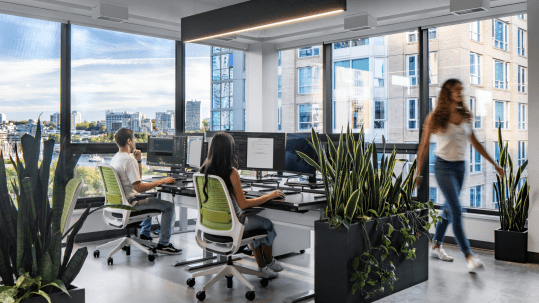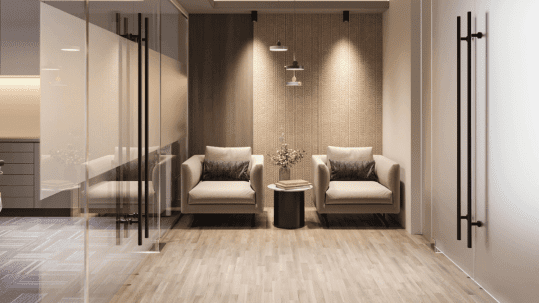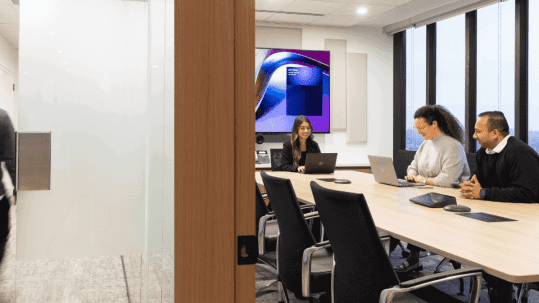Collaboration is a critically important aspect of successful modern office environments, but focus will always rank higher as a means of building effective and productive workplaces. Maximizing office productivity with a focus space allows employees to independently dedicate attention and concentration to tasks and projects in a way that can’t be replicated in the hustle and bustle of offices shrouded in non-stop socialization.
In open concept office spaces, employees are encouraged to balance learning, socialization, and collaboration, but central to those work threads is focus. In this post, we’re looking at how to maximize office productivity with a focus space, and how focus is pivotal to the effectiveness of a great office culture.
Balancing Working Threads
Contrary to popular interior design of the modern day and age, effective offices can’t be centralized around a killer cafe space and a company gym. While these environmentally safe havens for socialization and emotional well being may help balance work and personal life with some breathing room, many employers and office designers neglect to balance them with the good stuff: hard work and focus.
There are four main vessels of workplace design:
- Collaboration
- Learning
- Socialization
- Focus
The goal of an optimized office is always to find applicable ways to freely change up an employee’s surroundings so they can use specific spaces for specific tasks — with the fall from grace experienced by the cubicle-style office, private space to use as a means of individual focus went with it.
When focus is neglected, the other working threads wind up taking up the slack, disproportionately affecting the office’s ability to simply chill out and focus on their immediate tasks. Meanwhile, integrating dedicated focus spaces is key to retaining that balance and maximizing office productivity.
Multipurpose Office Design
Cue a multipurpose approach to interior office design. Modern office spaces are not designed with singular uses in mind – instead, they’re curated to become different things, to different people, at different times.
Multipurpose office design often favours these flexible spaces that are easy-going in nature and open to vast amounts of collaboration, so they inevitably leave privacy and quiet on the wayside. But this isn’t a sob story against new-school multipurpose spaces – rather, an opportunity for multipurpose spaces to better accommodate focus spaces.
Building Focus Spaces
Multipurpose spaces can transition to create focus spaces using a number of modular and flexible furniture solutions, rather than by dividing spaces with barriers and walls that prohibit connectivity between people.
Instead, a simple shade, flexible workspace divider, and focus-oriented cubes. Focus spaces can be built using any number of flexible tables, chairs and screens to create semi-private work hubs for moments of quiet concentration.
Take for example, acoustically tailored cubes, or pods. These sound-insulated work stations are geared towards mobile workers seeking respite from the noise and visual stimuli of an open concept space using a sound-absorbing interior. They’re mobile, private, and act as pseudo blinders for employees seeking a space to be with their own thoughts.
Similar furniture products can be found in flexible desk dividers that act as makeshift cubicles, isolating an employees’ workstation from view, also inhibiting discussion and chat from other employees. When focus and concentration is needed to complete a task or get a leg up on a project, simply erect the divider – when it’s time to revert back to collaboration mode, away it goes – making for fast and effective multipurpose transitions.
As a bare minimum, dedicating an entire corner of the office to focus and concentration-based tasks is a great way to create a visual cue that focus and solace are as important to organizational productivity as collaboration. Acoustic wall panelling can create a simple quiet zone for employees researching, or finishing a new project.
Zones
Sometimes, pop up dividers and soundproof chairs won’t cut it. So with quiet space and privacy at a premium within modern office spaces, the concept of acoustically engineered phone booth office structures have become very popular as alternatives to old school cubicles or private micro offices. These are ideal spaces for focus, and give employees a silent space to conduct client phone calls, answer emails, have video conferences, or simply brainstorm ideas for a project.
What’s best perhaps, is that these phone booths accommodate two or three people, so a focus space can also become a collaboration or discussion space where a small team can focus on a specific job within the office.
Modern room dividers and partitions are on the rise as well, using rotating sound-deadening panels to create an attractive abstract structure within the office that can be opened and closed – much like a set of blinds – to open up, or close off an entire area.
Focus-based Renovations
Sometimes, modular furniture doesn’t fit the aesthetic or identity of an office – meaning that a dedicated focus space is required to balance working threads. This means remembering that sound is relative, and reducing sound on an individual basis with a sound-cancelling pod can elevate and isolate other sounds in the vicinity – think about someone chatting in a library; the conversation they’re having becomes the only thing you can hear, while conversation in a coffee shop or restaurant between 50 people seems private by comparison. The key? Think about adjacencies and couple quiet zones with other quiet zones during a renovation.
Renovating to include focus spaces doesn’t mean putting quiet-seekers in another room, or isolating them from the action. Renovations of semi-private spaces with floor-to-ceiling glass, for example maintain an open concept and connected feel, while providing individuals and small groups with a space where they can focus their creativity away from distractions.
—–
The key to maximizing office productivity via providing focus spaces lies in an employers’ ability to offer employees with lots of choice. Staff need choices to find a space that suits their work style, and allows them to focus and concentrate in their own way. Whether it be with furniture choices, partitions, phone booths, room dividers, semi-private focus spaces, or even a set of company headphones – focus is essential to boosting office productivity.
Without a space to use for focusing, employees can find themselves searching for solace and room to focus on their work. It’s this balance of working threads that helps staff remain effective throughout the workday.






